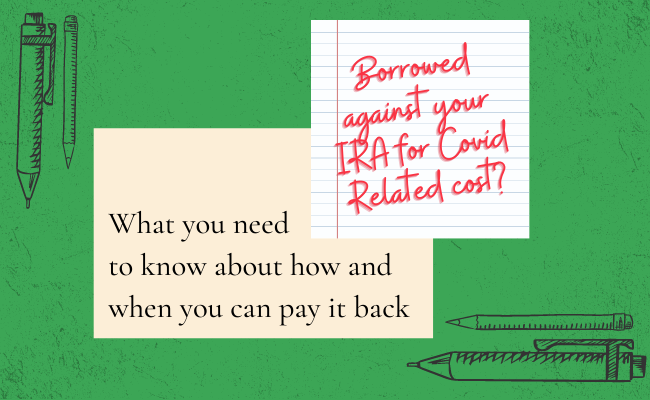Borrowed against your IRA for Covid-Related cost? Here is what you need to know.
You Took Coronavirus-Related IRA Money Last Year: What Now?
Like most of us, the pandemic has left an indelible mark. You may have been eligible to take tax-favored coronavirus-related distributions from a traditional IRA. This is known as Covid-related Distribution or CVD.
What does that mean for you this year and how to get the best results for your income tax?
CVD Basics
If you were eligible, you could have taken one or more CVDs from one or more traditional IRAs in 2020, up to a combined limit of $100,000. (First, hooray for you for having that much in your traditional IRA!)
Tax advantage:
You can recontribute the CVD amount(s) back into one or more traditional IRAs within three years of the withdrawal date(s). You treat each withdrawal and later re-contribution within the three-year window as a federal-income-tax free IRA rollover transaction. (Say what?, now that’s a win!)
Non-Tax Advantage:
There are no restrictions on how you can use CVD funds. You can use the money to pay bills and recontribute later—within the three-year window—when your financial situation permits. You can help out your adult kids now and recontribute later. Whatever.
A CVD can be useful as a tax-favored cash-management tool. Nice!
Something of note: The favorable tax treatment applies equally to CVDs taken from garden-variety traditional IRAs, SEP IRAs, and SIMPLE-IRAs.
Now the important stuff: You MUST recontribute within 3 years!

Original Eligibility Rule
According to the CARES Act, a CVD is a distribution of up to $100,000 from an eligible retirement plan, during 2020, to an individual
- Diagnosed with COVID-19 by a test approved by the CDC
- Spouse or dependent was diagnosed with COVID-19
- Experienced financial consequences as a result of being quarantined, furloughed, or laid off, or having work hours reduced
- Financial consequences because of a lack of childcare due to COVID-19
- Anyone who owned or operated a business that closed or had operating hours reduced due to COVID-19 and experienced adverse financial consequences as a result;
- People who experienced adverse financial consequences due to other COVID-19-related factors specified by IRS guidance.
Liberalized Eligibility Rule
IRS expanded the statutory list of individuals who were eligible to receive CVDs to include those who, met any of the following descriptions:
- Individuals who had a reduction in pay or a reduction in self-employment income due to COVID-19.
- The individual had a job offer rescinded or the start date for a job delayed due to COVID-19.
- A spouse or a member of the household was quarantined, furloughed, or laid off due to COVID-19,
- Had work hours reduced due to COVID-19, or was unable to work because of a lack of childcare due to COVID-19
- A reduction in pay or in self employment income due to COVID-19
- Job offer rescinded or the start date for a job delayed due to COVID-19
- The individual, or the individual’s spouse or a member of the individual’s household, owned or operated a business that closed or reduced hours due to COVID-19.
Something of note: A member of an individual’s household is considered someone who shares that person’s principal address. (so not your in-laws that live somewhere else)
The Downside: The Tax consequences (Think ominous music here…)
It’s true that if you recontribute a CVD amount within the three-year window, the ultimate result is the same as a federal-income-tax-free IRA rollover.
Unfortunately, you must put up with some potentially awkward interim tax consequences before you arrive at the tax-free-rollover-equivalent outcome. The interim tax consequences can diminish the cash-management advantages of the CVD deal, and they require filing amended returns to gain federal-income-tax-free treatment.
Shameless plug: We can help you navigate through these amendments, or if possible help you avoid them all together!
If you take several CVDs (up to the $100,000 combined limit), the interim tax consequences apply separately to each CVD.
Potential Negative Impact of Higher Tax Rates
The IRA withdrawal is income. You may potentially fall into a higher tax rate for the three years. (NOOOOO!) Even if you recontribute the entire CVD amount within the three-year window. A rate increase may happen. You may be looking at a higher tax rate based on the money withdrawn. As long as you recontribute the entire CVD amount within the three-year window, you’ll eventually get back some of those increased tax rates, but fare warning that might not be so easy. More to follow when the government clears this up!
Tax Results If You Don’t Recontribute Within the Three-Year Window (Think 80’s horror soundtrack, Just kidding!)
You always have the option of simply keeping all or part of your CVD money. You’ll have taxable income from the CVD amount that you don’t recontribute. You can spread the taxable income from the CVD equally over three years under the three-year ratable income inclusion method, or you can elect to report all the CVD income on your 2020 Form 1040.
If it later turns out that you have enough cash to recontribute within the three-year window, you can always decide to recontribute and recover any related federal income tax hit(s).
Good news. Regardless of what you choose to do with your CVD, you won’t owe the dreaded 10 percent early withdrawal penalty tax that generally applies to traditional IRA withdrawals taken before age 59 1/2. CVDs are completely exempt from the penalty tax. As well as SIMPLE-IRA are exempt from the 25% early distribution penalty tax that generally applies withdrawals taken before age 59 1/2
More good news. When you recontribute a CVD amount within the three-year window, it’s deemed to be a direct trustee-to-trustee transfer that’s exempt from the one-IRA-rollover-per-year limitation.
Bad news. According to IRS, beneficiaries of inherited IRAs can receive CVDs as long as they are eligible individuals, they can follow the three-year ratable inclusion rule to report taxable income from CVDs, and their CVDs are exempt from the 10 percent early distribution penalty tax.
Only an IRA CVD is eligible for tax-free rollover treatment. CVDs received by beneficiaries of inherited IRAs (other than the surviving spouse of the IRA owner) cannot be recontributed. So, no tax-free-rollover-equivalent deal for those folks. Sorry.
Tax Reporting and Procedural Issues
The IRS stipulates the following:
- Both you and the IRS will receive a 2020 Form 1099-R that reports the amount of your CVD, even if you recontributed the entire amount to the same IRA last year.
- You must treat all CVDs received in 2020 the same way.
- Either all must be taxed using the three-year tax income method or reported as income on your 2020.
- You cannot make or change this election to report all CVD income on your 2020 Form 1040 after the date you timely file your 2020 Form 1040, including extensions.
If You Choose to Report All CVD Income in 2020
You make the election to report all CVD income in 2020 and then report the entire amount of your CVD(s) as income on your 2020 Form 1040.
If you then recontribute all or part of the CVD amount on or before the due date of your 2020 Form 1040 (including any extension), don’t report the recontributed amount as gross income on your 2020 return.
However, if you recontribute all or part of the CVD amount after the due date of your 2020 Form 1040 (including any extension), you must file an amended 2020 return to remove the recontributed amount from your 2020 gross income, this will recover the related 2020 tax increase.
The amended return must include Form 8915-E to report the recontribution.

How to Handle Recontributions If You Use the Three-Year Ratable Income Inclusion Method
As mentioned earlier, you can spread the income from CVDs equally over three years, starting with 2020. If you then recontribute any CVD amount within the three-year window before the Form 1040 due date for the year of the recontribution (including any extension). The amount of the recontribution reduces the taxable rate for the year the payment is contributed too.
What’s the Best CVD Strategy for 2021-2023?
Good question. The increased tax rates for CVDs are inconvenient, and they can seriously reduce the cash-management advantage of the CVD privilege. But consider the following strategies:
- If your 2020 taxable income was much lower than usual due to COVID-19 economic fallout. (yay sort of) You might have a very manageable federal income tax from including the CVD income on your 2020.
- Lets say, you’ll have extra cash in hand. You can recover some of the 2020 tax increase by recontributing to the CVD amount within the three-year window. This will get the recontributed amount back into tax-favored IRA status.
- Or you can just keep all the cash and live with the 2020 tax hit.
- Say you had negative 2020 taxable income because of business losses due to COVID-19 economic fallout. Reporting all the CVD income on your 2020 taxes could be a very tax-smart move . By sheltering that income with business losses.
- You will have extra cash and will owe little or no federal income tax for 2020. If you have sufficient cash later on, you can recontribute to the CVD amount within the three-year window. Recovering all or part of any 2020 tax increase, and get the recontributed amount back into tax-favored IRA status.
- If you recontribute the CVD amount sooner than required, it will mitigate unfavorable increased tax consequences.
Something of note: For any CVD amount that was not recontributed by December 31, 2020, you have until October 15, 2021, to make the decisions that will determine how that amount will be taxed, as long as you extend the deadline for filing your 2020 Form 1040 to October 15, 2021. Or, if you have already filed, you could file a superseding return, as explained in Made a mistake on your taxes? Here is how to fix it before the IRS discovers them







